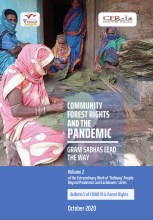Land Library Search
Through our robust search engine, you can search for any item of the over 73,000 highly curated resources in the Land Library.
If you would like to find an overview of what is possible, feel free to peruse the Search Guide.
/ library resources
Showing items 55 through 63 of 5898.A l’instar des pays producteurs de bois tropicaux dans le Bassin du Congo, membres de la Commission des Forêts d’Afrique Centrale (COMIFAC), la République Centrafricaine (RCA), située au cœur de l'Afrique entre 02°10' et 11°00' de latitude Nord, 14°40' et 27°45' de longitude Est, regorge d’énorme
The food system challenges require simultaneous action across different sectors and concerted efforts of diverse players in food systems.
The Lawra district of the Upper West region was selected as the case study. This study compared crop yields for FMNR and non-FMNR farmers. FMNR farmers are classified as having at least 8 trees per acre, with an average of 13 trees per acre (33 per ha) and a maximum of 40.
Executive Summary
Violence has spiked in Zimbabwe’s gold mining sector, costing hundreds of people their lives and triggering a police operation that led to the arrest of thousands.
This guide encourages communities to discover what development means for themselves and to question whether proposed plans and activities truly fit within their definition of and priorities for development.
This compilation of resources aims to help journalists cover the medium- to long-term impacts of the global pandemic on the governance of the oil, gas and mining industries in resource-rich countries.
Can historical and political circumstances change the meaning of such a solid and immutable phenomenon as a country’s geographical location? We mean, of course, “change” in terms of a country’s favourable or unfavourable place in the international economic and political system that surrounds it.
India is currently among the most affected countries by COVID19, recording over 6 million cases, by September 30 2020.
Public spaces are believed to make cities more liveable, healthy and socially equal. To date, discussions about public spaces have primarily revolved around emblematic types, such as squares and parks, while little attention has been paid to cemeteries.





